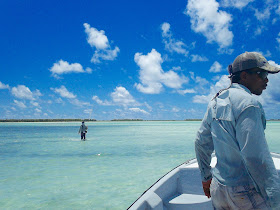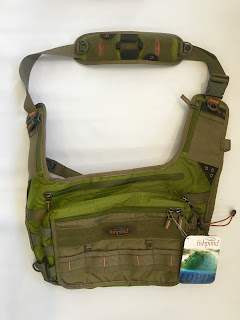Thumb Up Fly Casting Application
Lefty Kreh was the master teacher for fly casting, and
appropriately so. I’ll never forget his
appearance at a convention in the Ozark Mountain Springs site in northern
Arkansas where he gave a presentation in which he began by demonstrating a
technique whereby he first cast the line for an extraordinary distance with the
full rod, then with the rod tip only in hand, and finally with his hand and
line only. He emphasized several
sustaining issues. First and foremost,
use the tip of the rod, and technique, not your arm to cast the fly. To this purpose, the back cast should not
pass 2 o’clock and fore 11 o’clock.
Everyone has some tendency to exceed that boundary, most especially
beginners. Most over-power the line with
a firm and excessive grip. That is one
reason women more easily adapt to the requisite better form, with less tendency
to overpower the rod with wrist and arm.
As a doctor fisherman, I have a facilitating Rx for such a patient.
The casting hand has five fingers. I recommend a divided responsibility, using
the thumb as a backboard for the rod’s back cast which automatically achieves
the requisite short back rod movement of the tip to 2 o’clock with its straight
up block. (for the rod tip to stop at 2, the rod base cannot pass 12 o’clock). The forward motion to 11 o’clock is a simple
thumb push forward like ringing a doorbell.
There is no downward motion towards the water as the “tight loop” goes
straight out at eyelevel to drop peacefully onto the water at the end of the
line. It works the same for whether a
full backline cast or a looping roll cast.
You want to feel the tip of the rod casting, not the whole rod, and to
use it well it helps to “feel it” do its work.
That’s up to the thumb block back and the short straight snap forward.
The forefinger and middle finger remain free to accept the
line management responsibility. They
first secure the line against the rod for a tight string back cast, and then
drop free with the cast to give line to the forecast instead of gripping the
rod, a softening maneuver to prevent overpower and tight grip. It also frees them for a quick translation of
the line which needs to return to those now extended two rod fingers as the fly
drops lightly to the water in preparation for “stripping” by the other free
hand as soon as the fly alights on the water, ready for instant fish strike and
maintaining a “tight light straight line” capable of immediate soft hooking of
imminent fish strike. So the thumb
accommodates the 11-2 o’clock ideal path of the rod tip while the next two
fingers stay free for line management.
That leaves the bottom two fingers to hold the rod, discouraging
overpower and facilitating a soft quick hook set. Hard sets pull the fly out or break the tippet,
especially on the larger trout.
One additional tip to avoid the tangle that occurs secondary
to the line “running into itself by the back cast incompletely laid out behind
hitting the loop of the forecast” is to follow a different pathway, one back
and the other forward; i.e. if you come back with a straight up vertical,
deliver with a slight sideward cant for the forward path and, vice-a-versa, if
you want to do a straight overhead vertical forward cast, bring the back cast
proceeding with a slight sidearm tilt.
Obviously you don’t want to have to watch the back cast to see the exact
moment of its finishing straight out back, and the timing depends on how much
line you have out, much longer for a lot than a little.
Lefty has a massive wrist and forehand and gifted intuitive
rod motion that is perfected he can achieve a remarkable distance even by hand
and arm without rod. Most fly fishermen
put out way too much line and cast much further than necessary for maintaining
a no drag drift of the fly. It is
amazing the distance that can be achieved without much effort when the tip of
the rod is the managing tool instead of the arm or wrist which lose feel for
the tip.
A high percentage of takes (or strikes) occur almost
instantly as the fly alights upon the water.
The earlier one can prepare for this instant “soft set” of the hook
without jerking the better. To
facilitate this readiness the hands need to be in a close to one another
position for a sharing transfer of the line to the two awaiting fore and middle
fingers of the rod hand. This sharing
transfer improves line control for setting the hook as both hands become
involved. Fishing upstream against the
current requires “stripping” as soon as the fly lands to keep a “tight line”
without loops and without disturbing the free float of the fly downstream
towards you. Both hands likewise are
needed to feed line forward on a downstream cast to allow a “drag free drift”
of the fly without so much slack as to hamper a quick set on a downstream take.
When casting less than 10 feet of line after the 9-12 foot
leader and tippet, it is best to keep the free line hand close to the rod
gripping hand for quick transfer. When
casting longer lines, and especially when using a single or double “haul” for
maximal distance, as in salt water fishing, the diverging free hand used to
hold the line during the cast needs to return to the rod hand as the line
extends straight out before the fly hits the water so that the rod hand fingers
can secure the line for a take at the moment the fly hits the water. Then too, stripping in of line as the fly
drifts towards you on an upstream cast has to begin as soon as the fly hits the
water without any disturbance of the natural downstream drift, the speed of
which has to match the water current flow.
The forementioned “light and easy” style gives automatic
sense and feel to the tip of the rod which is the essence of a soft but
sufficient small loop and straight line out for dropping softly to the water
from eyesight level instead of splashing downwardly unlike a mayfly. And quick soft hooking are a prerequisite for
catching more trout. The hardest part of
the sport is achieving a quick and undamaging release of the trout to maintain
a good life in the water. That’s a
subject for another day.
Walter A Ruch
Taylor Creek Customer and Fryingpan Aficionado
Photos courtesy of Taylor Creek and Outdoor Sporting Library














































